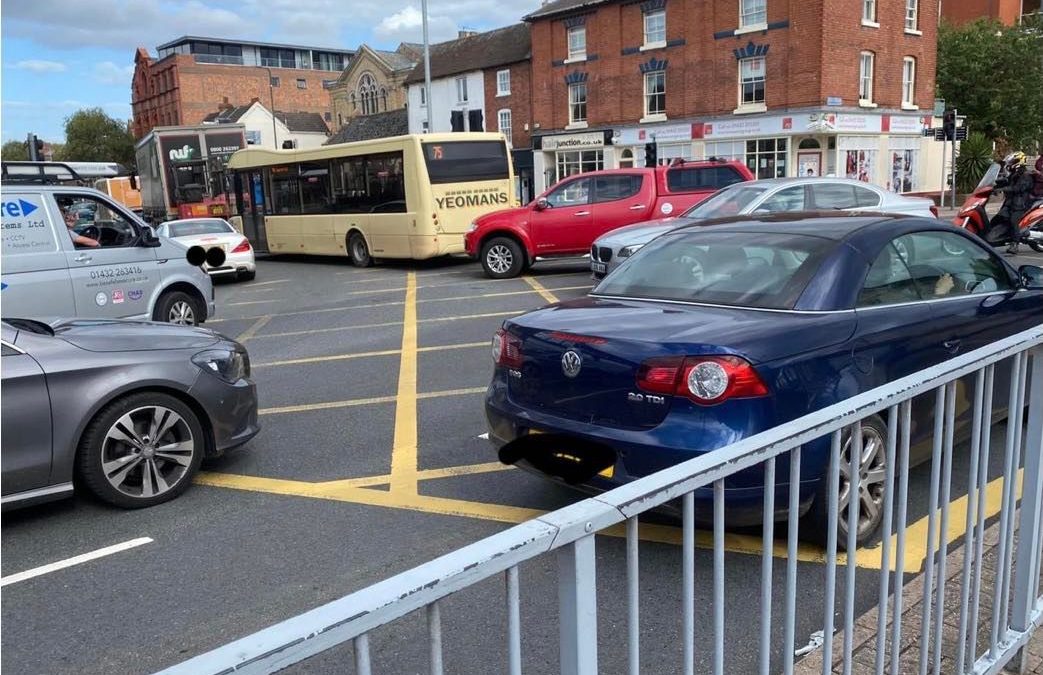On the back of the Government’s decision last year to let councils outside London and Cardiff apply for powers to enforce moving traffic offences, some 27 local authorities have put forward proposals to enforce 111 yellow box junctions, a new report from the RAC reveals.
After commissioning chartered engineer Sam Wright, who was formally responsible for the design and approval of yellow boxes on the Transport for London road network, to review the applications the RAC believes there are issues with 90% of the boxes which are likely to lead to drivers being fined unfairly.
In fact, more than half (61, or 55%) directly contravene the current government guidance, sometimes on multiple counts. The junction breaches include:
40 that pose visibility issues for drivers
16 that are on the side of the road opposite T-junctions which the Department for Transport (DfT) states serves ‘no useful purpose’
18 that extend beyond junctions such that they may be considered non-complaint with the regulations
9 that are in non-permitted locations according to the regulations
Last year the RAC asked Sam Wright, who runs the website Yellow Box Guru, to write a report on best practice for enforcing box junctions which highlighted gaps in the DfT’s guidance and a general lack of knowledge and understanding that could lead to many unfair fines being issued.
The purpose of yellow boxes is to prevent the blocking of ‘cross’ or ‘through’ traffic movements. If a box, or part of a box, does not protect a cross movement, it serves no purpose and any fine issued there is unnecessary.
Two of the biggest issues with many of the yellow box junctions that councils are looking to enforce relate to visibility and size – something that’s covered by the official guidance and has been reiterated by the previous Chief Adjudicator of the Traffic Penalty Tribunal. Drivers need clear visibility of the box, and where it ends, in order to comply with their duty to only enter it if their exit is clear. If visibility is unclear, then fines are unfair. Unfortunately, consultations have shown that many of the boxes proposed to be enforced do not conform with this requirement because visibility is blocked, boxes are too large for drivers to see where they end, or they simply do not cover cross movements.
The report’s findings show 90 (81%) of the boxes proposed for enforcement are unnecessarily large and 40 boxes (36%) have visibility issues. In some cases, drivers can’t even see there is a box present because of faded road markings, let alone where it ends.
Sam Wright said:
“Visibility issues are connected to the road layout, topography, buildings, box length, street furniture, trees, or a combination of these.
“While many boxes are barely visible at the moment due to a lack of maintenance, I chose to ignore this on the assumption that lines will be refreshed prior to enforcement. Crucially, I haven’t seen a single proposal that reviews the visibility of the box from a driver’s point of view. If you also factor in bad weather, poor light and other vehicles, then the poor visibility situation is exacerbated.
“This is all very concerning, especially as enforcement is carried out via cameras high in the air.”
The RAC review also found councils are planning to enforce 16 boxes at the far side of T-junctions, something which goes against the DfT guidance which states: ‘A half‐box on the side of the road opposite a T‐junction generally serves no useful purpose’.
There are also 18 boxes that extend beyond junctions such that they may be considered non-compliant with the regulations, based on previous rulings by adjudicators in London. While they definitely serve no purpose, whether or not they are a breach of the regulations is not clear because the DfT does not specify exactly where junctions start and end.
Nine junctions proposed for enforcement are in locations that are not stipulated in the Traffic Signs Regulations and General Directions (2016).
These include boxes at roundabouts and gyratories without traffic lights and outside a private car park. Hertfordshire initially proposed to enforce a junction outside a private car park but dropped the idea after launching its consultation.
Sam Wright added:
“Many of the boxes have been around for years, perhaps decades. It appears that many authorities have simply assumed that the boxes already on the ground are suitable for enforcement without carrying out a fresh assessment as is recommended in government guidance.
“There are many changes needed to improve yellow box law and enforcement. However, as a minimum it is not unreasonable to expect that authorities should undertake comprehensive audits of boxes prior to enforcement to assess all issues.
“Unfortunately, there is no evidence in any of the consultations that such audits have been carried out. This means action is needed by the Department for Transport to both review existing guidance and compel mandatory audits prior to enforcement. We believe this will help to ensure transparency and fairness in enforcement.”
RAC roads spokesperson Simon Williams said:
“Unfortunately, it seems many of the concerns we highlighted a year ago have started to become a reality. The issue of box size is not adequately addressed in the Government’s guidance which means many drivers will end up being unfairly fined.
“Fining people can have real financial consequences for those on the receiving end. Enforcing yellow boxes means that the driver of a vehicle overhanging a box by any amount for just a moment can get a ticket.
“Yet many drivers end up stopped or trapped in these junctions through no fault of their own. It is not only imperative, but a moral duty to ensure that fines are fair, justified and that the appeals’ process is consistent across the country.
“And in some cases, we believe enforcement may end up actually increasing congestion as a result of drivers hesitating before moving on for fear of being fined. This is the exact opposite of the justification for enforcement being undertaken.
“We urge the Government to carry out an urgent review of its yellow box junction guidance and clarify what is and isn’t enforceable. It’s vital that size and visibility issues are resolved once and for all. Councils should then be ordered to carry out audits of all the junctions they propose to enforce, including from the driver’s perspective. And, if adjudicators find councils have wrongly enforced junctions, they must be obliged to refund any fines issued and correct the junctions in question.”
REVEALED – You could soon be fined if you stop in a yellow marked box in Hereford.
Herefordshire Council has been asking residents for their views on the introduction of measures to enforce moving traffic regulations.
This includes stopping in yellow boxes at junctions, ignoring no-entry signs, making banned turns, contravening ‘access only’ routes and parking on yellow zig-zag lines outside schools.
Traffic regulations act to make the roads safer for all users and to help keep traffic flowing in busy areas.
Changes in Government legislation (implementation in full of Part 6 of the Traffic Management Act 2004) mean that councils in England will have control of enforcement powers for moving traffic contraventions, previously held by the police. Measures to enforce moving traffic regulations include the installation of cameras and the issuing of penalty notices.
Councillor John Harrington, Cabinet member transport and infrastructure said:
“Road safety for all users, however they travel, is a key concern. Traffic regulations help make roads a safer environment and enable traffic to flow freely. They help increase safety for example by preventing stopping on zig zag lines outside of schools and driving up streets the wrong way, and help traffic flow better by preventing blocking at key junctions.
“We would like to hear from all residents, whether they drive, cycle or walk, for their feedback on driver behaviour and the areas in our towns and City where better enforcement of traffic regulations may be needed.”
In July 2020, the government announced plans to improve cycling and walking uptake in Gear change – a bold vision for cycling and walking.
As part of this strategy, the Department for Transport is changing the way moving traffic contraventions are enforced. Currently, only London and Welsh local authorities have powers to enforce these restrictions by the issue of a penalty charge notice.
The new regulations will be coming into effect in summer 2022, as a result, a number of new contraventions will become enforceable by councils rather than the police.
The changes are yet to be enforced in Herefordshire, but plans are in place to introduce them in the coming months and years.
These new powers will enable enforcement of the following restrictions by camera:
One way streets
Banned turns
Pedestrian zones
No entries
Yellow boxed junctions
Cycle and bus routes
Restricted access/weight limits
Stopping on school keep clear markings
Herefordshire Council has indicated its intention to the Department for Transport to adopt these powers in order to promote a safe environment for all road users and to allow traffic to flow freely.
The locations are also listed in the following table:
| Location: A438 / A49 Junction (Steels), Hereford | Vehicle restriction type: Yellow box |
| Location: A438 Eign Street / Aldi junction, Hereford | Vehicle restriction type: Yellow box |
| Location: A49 Edgar Street / Tesco roundabout, Hereford | Vehicle restriction type: Yellow box |
| Location: A49 Victoria Street / Barton Road, Hereford | Vehicle restriction type: Yellow box |
| Location: Bewell Street, Hereford | Vehicle restriction type: No entry except access |
| Location: Blueschool Street / Widemarsh Street, Hereford | Vehicle restriction type: No entry except access |
| Location: Blueschool Street, Hereford | Vehicle restriction type: Yellow box |
| Location: Broad Street, Hereford | Vehicle restriction type: One way |
| Location: City Link Road / Widemarsh Street, Hereford | Vehicle restriction type: Banned turns |
| Location: Commercial Road / Stonebow Road, Hereford | Vehicle restriction type: Yellow box |
| Location: Commercial Road / Union Walk, Hereford | Vehicle restriction type: Yellow box |
| Location: Commercial Square (outside The Kerry), Hereford | Vehicle restriction type: Yellow box |
| Location: East Street, Hereford | Vehicle restriction type: No entry except access |
| Location: High Town (St Peters), Hereford | Vehicle restriction type: No entry except access |
| Location: Holme Lacy Road (Near Goodwin Way) | Vehicle restriction type: Weight restriction |
| Location: Offa Street | Vehicle restriction type: One way |
| Location: Prior Street | Vehicle restriction type: No entry / one way |
| Location: Springfield Avenue / Hunderton Avenue) | Vehicle restriction type: Contravention of no entry / one way |
| Location: Widemarsh / Conningsby Street | Vehicle restriction type: Yellow box |
| Location: Ginhall Lane / Green Lane, Leominster | Vehicle restriction type: Banned turn |
| Location: C1259 from A40, Goodrich | Vehicle restriction type: 7.5t weight limit |
| Location: Knapp Lane, Ledbury | Vehicle restriction type: 3.5t weight limit |
| Location: Town centre (various streets), Bromyard | Vehicle restriction type: 7.5t weight limit |
| Location: All schools | Vehicle restriction type: Yellow no stopping zig zag |




